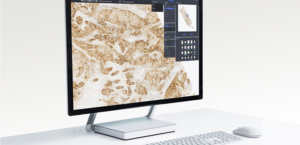We believe that Roche is doing an awesome work improving the laboratory in the healthcare system, integrating all of the ancillary tests to make an accurate diagnosis with the best and most novel technology.
In March 2021, three of the ESRs did an online secondment at Roche Diagnostics, S.L.U. In this post, Claudio (ESR6), Laëtitia (ESR7) and Andrés (ESR12) will present what this secondment consisted of, and what we learned from it.
This virtual secondment was composed of several workshops and webinars, both synchronous and asynchronous. These workshops presented different aspects of cancer, regarding not only the diagnosis process, but also the treatments and data handling in general. While some webinars mainly focused on clinical knowledge in pathological anatomy and oncology, others were oriented towards the latest digital solutions and diagnostic supports.
Some of the workshops to which we attended include the following:
- New tools for breast cancer diagnosis
- ALK (D5F3) and ROS1 (SP384) in lung cancer – guiding, advices and practical cases
- Precision medicine day: a reachable challenge
- LABCLIN2020 Workshop – From integration to data analysis: clinical laboratory’s digitalization
Because of the multidisciplinary background between medicine (Andrés) and engineering (Claudio and Laëtitia), we describe our opinion in two parts: from both a pathological point of view and an engineering one.
From a pathologist point of view (Andrés-ESR12):
Given that I have a pathology-oriented profile, this secondment allowed me to dig deeper into the aspect of computer-aided diagnosis with the application of artificial intelligence algorithms.
Roche has created a novel software called uPath that helps in an objective way the pathologist to count and interpret immunohistochemistry markers in different tumors based on artificial intelligence models. This software is able to identify the cells that express these components, with an almost exact interpretation of the percentage of positive cells in the field that has been chosen to be analysed. This software is capable of interpreting immunohistochemistry biomarkers and in situ hybridization.
I can conclude that by seeing these presentations, technology generates a very important solution for the problems that occur daily in the laboratory and in tumor pathologies. The idea of integrating the different diagnostic methods becomes essential for classifications of diseases and generates hope that precision medicine will be more effective. This also creates an open door to multiple investigations and artificial intelligence can be a solution to integrate all clinical and laboratory aspects and generate results much more beneficial to the human suffering from a disease.
From a non-pathologist point of view (Claudio and Laëtitia – ESR6 and ESR7):
As we both have an engineering background, this online secondment allowed us to dig deeper into the pathology and oncology fields, providing us with the adapted medical terms and general clinical knowledge. Being aware of the clinical context of our projects is essential in order to better understand the problems at hand. As early stage researchers focusing on the characterization of specific cancer types with histological data (triple negative breast cancer and spitzoid cutaneous lesions), knowing about the different factors that are taken into account by a pathologist to make a diagnosis is primordial to develop algorithms and AI models that can not only mimic how experts take a clinical decision, but also to try to enhance the diagnosis rates. Besides, in this secondment we also learnt about additional concepts of the field, such as the whole process undergone by a slide from the moment the biopsy is taken from a patient, to the moment it is digitized and ready to be used for AI algorithms.
To sum up,
Having both pathology and engineering -oriented profiles allowed us to discuss the webinars we attended, helping one another understand the concepts of the field the other is not from. This combination of multidisciplinary backgrounds within CLARIFY is an amazing opportunity to join our knowledge to reach the objectives of the project.

One of the new tools for the diagnosis of breast cancer that was presented in the first synchronous webinar to which we all attended
Claudio, Laëtitia and Andrés – ESR6, ESR7, ESR12

